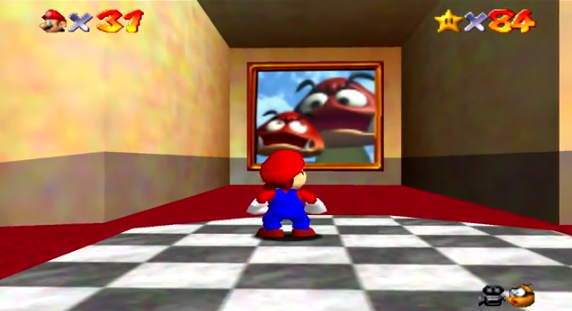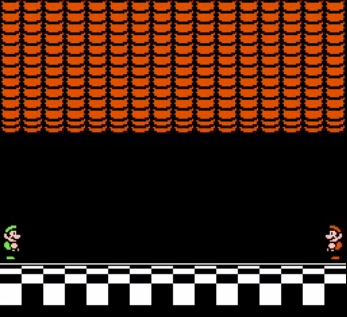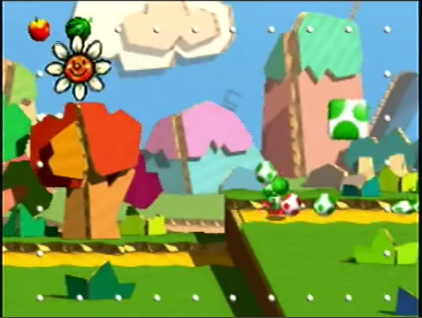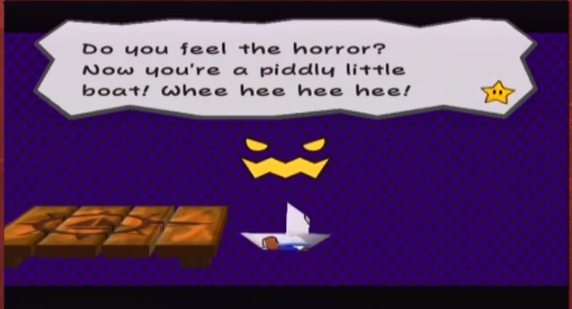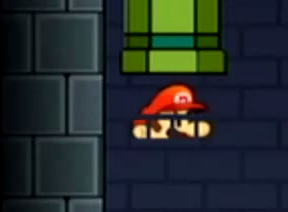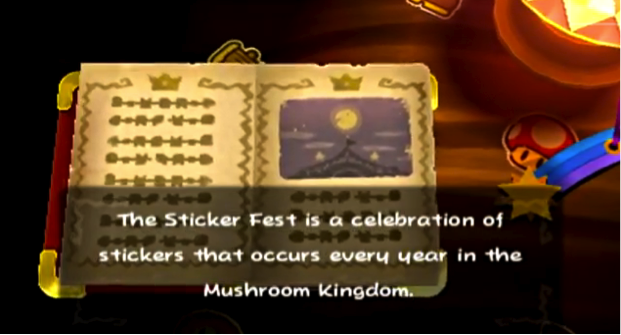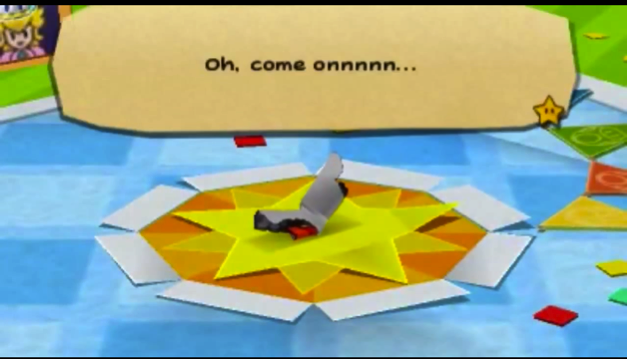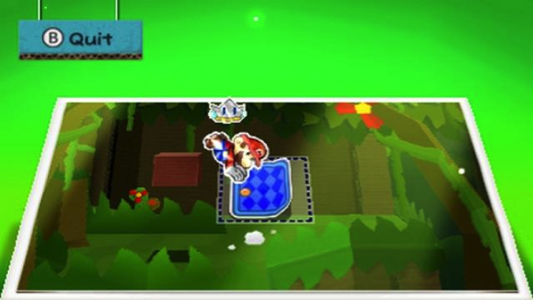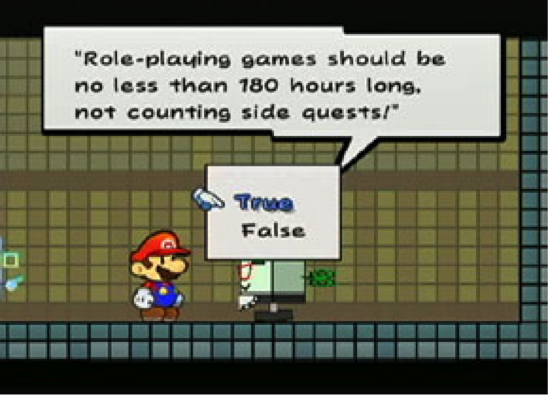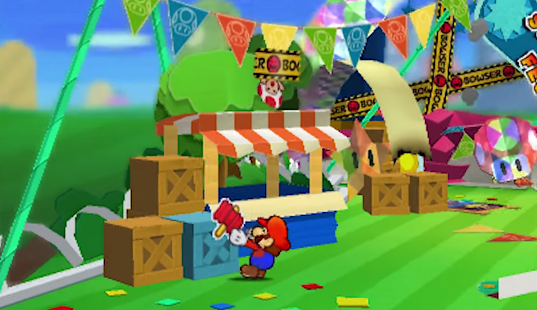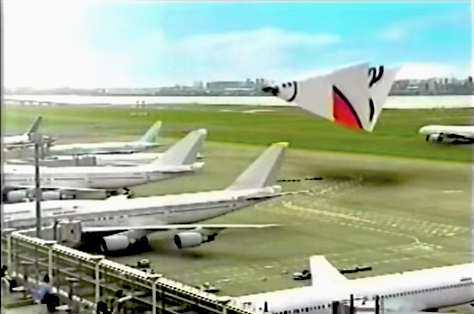Volume 5, Issue 1, December 2015
Andrew Campana
Harvard University
Abstract
Nintendo’s Paper Mario franchise is aesthetically and mechanically centered around the interactions between the flat and the solid; at its core is a playfulness with dimensionality that consistently highlights not only the 2D or 3D, but the 2.5 dimensional. Through this lens, I examine each of the four Paper Mario video games, as well as their predecessors and related merchandise. The 2.5 dimensionality that is consistently thematized in these games enables us to think about a more holistic conception of the « media mix » that not only actively breaks down the distinctions between different media, but also between the worlds « within » and « outside » of the game.
Keywords: Video games, media mix, Nintendo, Mario, dimensionality
Résumé en français à la fin de l’article
*****
Introduction
In a Japanese commercial for the 2004 Nintendo GameCube game Paper Mario RPG (in its English language released the same year, Paper Mario: The Thousand-Year Door), a giant two-dimensional Mario figure, standing on a real-world airport tarmac, jumps up, folds himself into an airplane, and flies off. In another variation, waist-deep in a river, his head droops over a suspension bridge, until he rolls himself into a tube and spins around and around (Video 1). In the third, he edges sideways to emerge from the tiny gap between two skyscrapers. « Perapera Mario no fushigina daibouken! » says the announcer in each case: the big, mysterious adventure of the paper-thin or flip-flopping Mario.
Video 1: Compilation of Paper Mario RPG Commercials
It is a small but clear shift from what is highlighted in the commercials for its predecessor, the Nintendo 64’s Mario Story (Paper Mario in English), in which a pensive Mario on vacation ruminates about whether or not he has forgotten something in the midst of the parties, golfing and tennis games in which he has been participating. « Sou da! Bouken da! » the announcer exclaims; « That’s right! It’s adventure! » In other words, while both of these action-incorporating RPGs feature paper-thin, two-dimensional characters in a three-dimensional setting (hence the series’ name), moving from Mario Story to Paper Mario RPG, the focus shifts from what Mario does to what he is—from the story-book like adventure of the former (held up in contrast to the non-narrative Mario games out at the time like Mario Party or Mario Golf) to the materiality of Paper Mario himself. By “materiality” I mean the implications and particularities of his paperness: the possibilities for the player’s interaction with him, as well as the modes of his own interaction with the world (« in » and « out » of game) contingent on his thingness as a paper-object-made-digital/digital-object-made-paper.
In this essay, I will use the concept of 2.5-dimensionality to investigate what the titular « paper » of the Paper Mario series of video games and associated merchandise represents and can generate—that is to say, the different articulations of materiality, intermediality, and self-reference incorporated into each of the four games, and how these lead us to a reconceptualization of video games in relation to other media. How might we characterize the shifting relationship in the series between “in game” and “out of game,” the “digital” and “real”? How do the Paper Mario games position themselves within, against, or alongside the wider Mario franchise? The goal of these considerations will be to show how the Paper Mario games in particular tell us about the flows of production, consumption, interaction and reflection within the Mario “media mix”—the interrelated array of games, television shows, figurines, books, and just about every other imaginable form of merchandise—and, more broadly, point towards what a conception of « media mix » might look like that actively breaks down the distinctions between different media and between the « inside » and the « outside » of the game world.
2.5-Dimensionality
One common way of categorizing video games is as two-dimensional or three-dimensional, « 2D » or « 3D. » « 2D » games, such as a side-scrolling platformers like Super Mario Bros. for the Famicom/NES, tend to have one plane of movement: in a sidescroller, characters, enemies and objects can move up, down, left and right and so on, but not seemingly « into » or « out from » the screen. Graphically, the characters and objects tend to appear flat (Fig. 1).
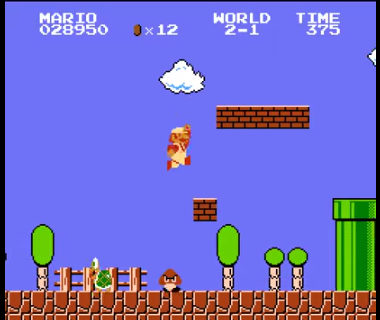
Figure 1: Super Mario Bros. for the Famicom/NES, one of the first Mario games and perhaps the most famous example of a « 2D » sidescroller.
« 3D » games became dominant with the 5th generation of consoles such as the Nintendo 64 and the Sony PlayStation, consoles that allowed for rendering of polygonal 3D graphics, and feature the movement of three-dimensional characters and objects in three-dimensional space. In games like Super Mario 64, this often takes the form of the player’s viewpoint being behind the character they control, moving forward into the gameworld (Fig. 2); in the case of « first-person shooters », the player sees through the eyes of the player character.
But a focus on the Paper Mario series and especially the importance of the titular « paper » within it reveals a consistent use not of a two- or three- but what might be called a 2.5-dimensionality. This term as it is conventionally used in the video game context tends to refer to certain graphical projection techniques (in games such as Super Mario Kart for the Super Nintendo) in which the illusion of three-dimensionality is created by the rotation and distortion of a 2D plane, common before the graphical capabilities of the fifth generation of consoles that included the Nintendo 64 (e.g. the Nintendo 64, Sony PlayStation, and Sega Saturn) allowed for polygonal rendering and « full » 3D (Fig. 3). When this technique was used in the Super Nintendo (in a graphics mode called « Mode 7 »), the sprites of the characters remained flat in appearance, in contrast to a seemingly 3D background. Indeed, the aesthetics of the entire Paper Mario series might be interpreted as a parody of Mode 7-style 2.5D (Ryan, 2011, p. 199).
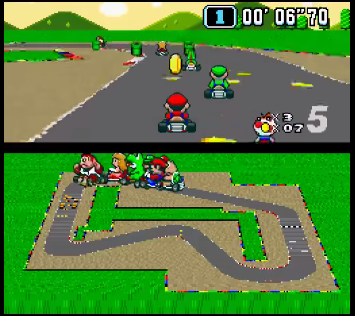
Figure 3: Super Mario Kart for the Super Famicom/SNES, with the flat sprites and « 3D » background characteristic of Mode 7 graphics.
One of the central themes of the Paper Mario series in both its gameplay and aesthetics, as indicated by its name, is playing with ideas of flatness and two-dimensionality in ways that differ from the « 2D » sidescrolling games for which Mario became famous. The two-dimensional is highlighted in these games not as a limitation of movement on a single plane, or as the realm of the graphicality and the « image » that exists separately from the three-dimensionality of the « real » world, but rather takes the form of flat objects (especially the paper-thin Mario himself) which can be distorted, moved through and effect changes in three-dimensional space (Fig. 4).
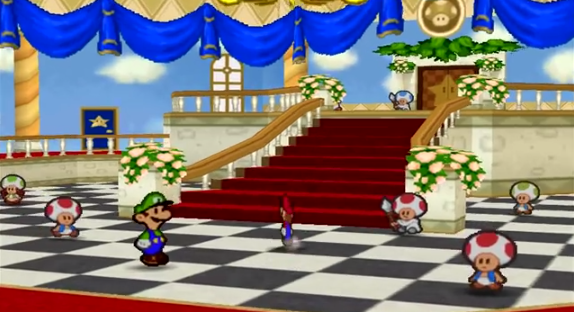
Figure 4: A scene from Paper Mario on the Nintendo 64, showing flat sprites in 3D environments. In the middle, Mario is in the midst of spinning around, revealing to the player the sight gag of his paper-thinness.
Such a playful mixture of 2D and 3D is not the exception when it comes to video games in particular and the experience of different media more broadly—in fact, it is exemplary. Our experience of the three-dimensional, for example, is always constituted by the combination of « two-dimensional » images to create an effect of depth, and our experience of the two-dimensional must similarly always be within a « three-dimensional » space. In our experience of these dimensions, within and outside of the realm of video games, the two are inextricable to the extent that it is often difficult and furthermore not useful to speak of them as two separate concepts. I would posit a broader notion of 2.5-dimensionality as a conceptual tool that refers not just to the illusion of three-dimensionality created using two-dimensional planes but to techniques that actively play with and reveal the arbitrariness of such dimensional distinctions in the first place. I highlight the Paper Mario series not as something exceptional but as a spectacular example of tendencies that exist in all games and among all forms of visual media to resist simple distinctions between « 2D » and « 3D » in favour of a playful 2.5-dimensionality. This is especially the case when these media are looked at in relation to one another, as in a « media mix, » the network of interrelated video games, toys, anime, movies, manga, novels, radio plays, musicals and so on that characterizes much of Japanese pop cultural production and the current scholarly discussion surrounding it.
Taking cues from the playful and complex dimensionality of the Paper Mario games and their relation to the broader Mario franchise points towards a different conception of the media mix, one that resists the tendency to use either the « flattening out » rhetoric of the transcendent 2D as a way to elide bodies and their environments, or the 3D as something « realistic » with a higher truth value in relation to our lived experience, allowing the 2D to be othered into a literally different plane of existence. This conception of the media mix instead takes as its baseline the extreme porousness among « media » and between « media » and « non-media » as reflected within the shifting realm of the 2.5D. The 2.5-dimensional highlights itself as a contingent and artificial construction, one in which the factors of the body, its surroundings, and the materiality of the interface—which are all too often elided in digital media studies in general and video game studies in particular—are still very much legible.
Paper Mario and its Predecessors
Nintendo is no stranger to the medium of paper. Primarily a playing card company for around the first seventy years of its existence starting in 1889, Nintendo was particularly famous for its flower-embellished hanafuda cards, which it still sells (a Mario-themed set was given to Club Nintendo members in 2007; see the traditional design in Fig. 5).
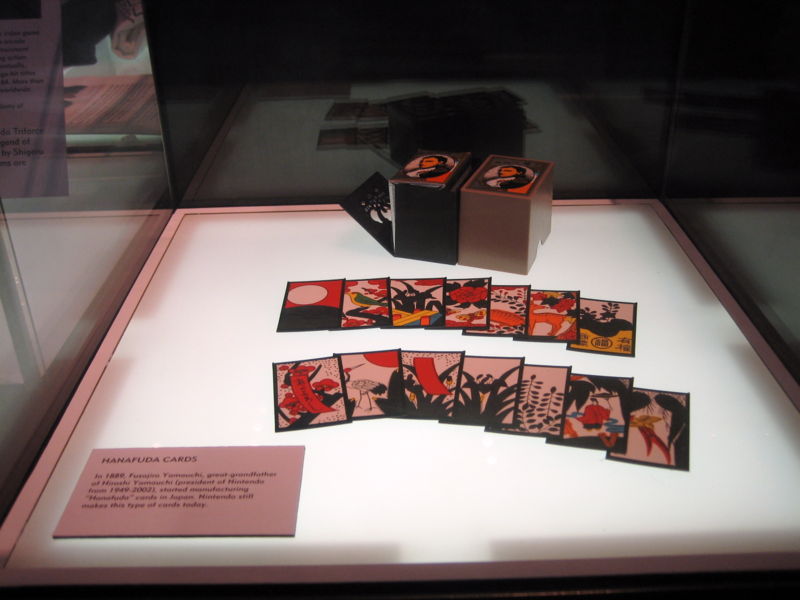
Figure 5: Traditional Nintendo Hanafuda cards, displayed at Nintendo World in New York City. Photo by Kate Haskell.
Even upon becoming primarily a video game company, however, many of Nintendo’s games—especially but not limited to the Mario series—have often had a central conceit, in terms of aesthetics if not mechanics, of remediating a particular “physical” medium in a way that informs its structure, art direction, and/or gameplay. Super Mario Bros. 3, the 1988 Famicom (and later NES) game, takes many of its visual cues from theatre: it begins and ends with the opening and closing of a red curtain (Fig. 6 below), many parts of the backgrounds appear to be two-dimensional—bolted to the wall or hanging from the rafters—and every level ends in a black portion as if Mario has gone into the wings of the stage. The Mario Party games are virtual recreations of boardgame boards, with characters rolling dice and advancing on spaces before engaging in a variety of minigames.
Though in terms of its mixed RPG and action gameplay mechanics the Paper Mario series can be seen as an extension of Super Mario RPG for the Super Famicom/SNES, in terms of aesthetics and art direction, however, its direct spiritual predecessor is the Yoshi series, the first Nintendo games to experiment widely with graphics derived from a distinctive arts-and-crafts aesthetic. The first of this series, the 1995 Super Famicom game Super Mario: Yoshi Island, is dramatically different from its predecessor, Super Mario World, in that its graphics look cartoonish, almost as if it were drawn by markers and pencil crayons: a platformer fused with a children’s picture book (Fig. 7).
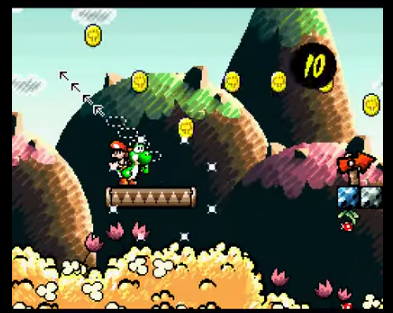
Figure 7: Yoshi Island for the Super Famicom/SNES, the opening stage demonstrating its drawn-by-markers visual aesthetic.
Two years later, Yoshi Story for the Nintendo 64 continued along this path, with graphics that looked like the settings and characters were put together with fabric, thread, tape, cardboard, and, of course, paper. Using « 3D » graphics in a side-scrolling « 2D » game, the picture book thus became something closer to a pop-up book (Fig. 8).
As a spectacularly 2.5-dimensional medium that plays with different relations of flatness and multiplanar structures, a pop-up book, or papercraft more broadly, is an appropriate comparison to describe the Paper Mario aesthetic as well (Fig. 9).
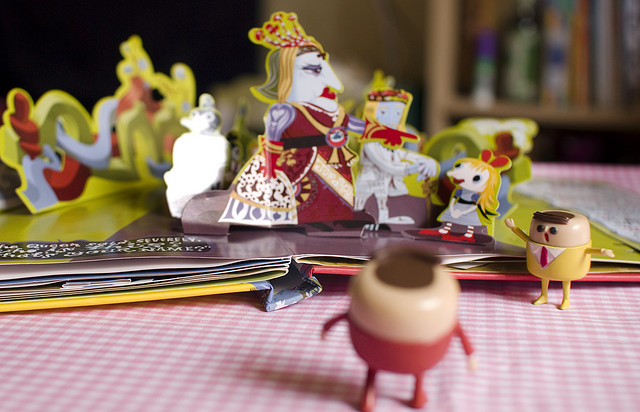
Figure 9: An example of a « real-life » pop-up book, telling the story of Alice in Wonderland. Photo by Fifi Yin.
Indeed, this is the main point of reference used to describe Paper Mario in the official Nintendo Online Magazine summary of Paper Mario RPG, along with kamishibai, another medium also key to evaluating the visual style of this series of games:
When I looked at the characters and the movement of Mario and so on, I recalled the fairy tale kamishibai-style puppet shows I often watched when I was small. Perhaps even more so than kamishibai, was the feeling of reading a handmade pop-up book (« Pēpā Mario RPG « , 2004).
Kamishibai—literally “paper theatre »—was perhaps the single most popular entertainment medium aimed at children in Japan from around the 1930s until the emergence of television—one of the terms by which television was known at first was in fact “electric kamishibai” (Orbaugh 2012, p. 79). Kamishibai consists of illustrated story cards, often with scripts written on their backs, which a travelling storyteller would use as the basis of a serial performance in a public space, selling candies to the gathered children for income; limited special effects were possible to create tension or surprise, such as controlling the speed at which panels were pulled out or dramatically removing inserted half-panels (Orbaugh, 2012, p. 85–86; see Fig. 10 for an example of a typical set-up). As referenced above, some later versions also came to incorporate paper puppets. In « Kamishibai and the Art of the Interval, » Sharalyn Orbaugh notes that the art style of kamishibai ranged from the flat, cartoonish, and multiplanar to a more « realist » mode. She associates the latter tendency with Cartesian visuality and perspectivalism which she ties to a worldview centered around the primacy of mind, rationalism, and « a conceptualization of the human self as stable and enclosed, separate from the world, and able to observe and judge the world in a detached, objective, rational manner »; this visual style was used to « order the [kamishibai] world in a certain way » and, in its role as wartime propaganda and beyond, invited the audience to do the same (Orbaugh, 2012, p. 79). She notes that many of the propagandistic kamishibai plays she discusses « exhibit an intriguing combination of flatness and roundness (three-dimensionality), ‘realism’ and stylization/abstraction—that is, they combine both Cartesian and anti-Cartesian visual elements, » each of which appeal toward different desires (realist/rational and emotional/psychological respectively) that together increase their impact: a vivid example of a non-digital medium that highlights 2.5-dimensionality in the way I am using the term (Orbaugh, 2012, p. 93).

Figure 10: A contemporary kamishibai performer in Tokyo. Note the stage-like wooden box, into which paper panels are inserted. Photo by Aki Sato.
Appropriately, kamishibai are clearly referenced in the first Paper Mario game, Mario Story [Paper Mario in English], highlighting the inherent theatricality of the video game medium and creating a 2.5D aesthetic space that allows for the irreverent and satiric but still nostalgic stance the Paper Mario series takes towards the Mario series as a whole. Mario Story opens with a blank background framed by a red curtain and a checkerboard floor (a clear nod to the aforementioned Super Mario Bros. 3). “Today,” says the unspecified narrator in a text overlay in the game’s English translation, “I’m going to tell you the story of ‘Star Spirits and Good Wishes’ » (Paper Mario, 2000).” The white backdrop is pulled aside to the left in a strikingly kamishibai-esque effect, revealing the glimmer of clouds and space and the Haven of the Stars. This again is pulled away to reveal the inside of the Haven itself. After a few more transitions, however, something is wrong: an angry koopa witch, Kammy Koopa, appears to have been roughly scotch-taped into the flat background of the scene (Fig. 11). “Oh dear…” says the narrator, “What the…? Who stuck that weird thing into this story?” (Paper Mario, 2000). Suddenly, Bowser, the main villain of the Mario series, pops up in front of the stage, facing away from the player towards the scene and nearly silhouetted by the stage lights: “Ha ha ha! Yeah! I did!” he says gleefully. “So I can, at long last, beat my archenemy Mario » (Paper Mario, 2000). The taped-in henchmen goes on to steal the star rod from the Star Haven depicted on stage, thus setting into motion the events of the game, and the at first unmoving paper backdrops are thrown into chaos as the animation changes into full « 3D » polygonal graphics as Bowser executes his nefarious plans. There is a shift into something like full Cartesian perspective as the camera zooms out from the plundered Star Haven, and then pans up into the starry night; the backdrop once again fades to white, the title card drops down from the curtain with Mario Story (or Paper Mario in the English version) written on a slightly crumpled piece of paper, and the player is instructed to press start.
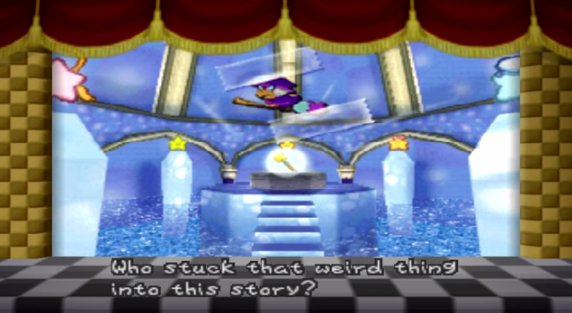
Figure 11: Kammy Koopa scotch-taped into the kamishibai-esque opening of Paper Mario for the Nintendo 64.
In the remainder of the game, however, apart from the paper-thin characters and the repeated sight gags of them turning around and revealing their lack of depth in the « 3D » world, the explicitly paper-like aesthetics, kamishibai-style or otherwise, are not highlighted in the gameplay; the world in which the characters move through and interact is depicted well within the semi-realistic 3D videogame conventions of the time, apart from thin doors and walls. Mario and his friends and foes are something like paper puppets, but only in terms of their flatness; indeed, they could all be replaced with 3D versions of themselves, and the gameplay would be essentially identical.
Fold—Paper Mario: The Thousand Year Door
Not so with its 2004 GameCube Sequel, Paper Mario RPG (Paper Mario: The Thousand Year Door), in which the paperness of the world and characters is not only central to the game’s aesthetics, but to its mechanics and gameplay. Recall the commercial described at the beginning of this paper, in which Mario folds himself into a paper airplane, moves sideways through tight spaces, and rolls himself into a tube; there was even a promotional item before the game’s release of a Mario-embellished sheet of paper designed to be made into a “real” paper airplane. A passage from the aforementioned Nintendo Online Magazine also demonstrates the way the appeal of the game was framed around the “paper” concept itself:
Up until now, various 3D and 2D Marios have appeared. So, this time Mario will be « paper. » « Paper, what do you mean by paper? » That might be a mystery, but it’s really funny and interesting how the characters are being represented as if they have become paper-like. When— »flip »—they spin around, they have basically no thickness, and— »whoosh »—when they’re blown, they up and fly away. It’s ideal for those who really want to go adventuring in a strange world! (« Pēpā Mario RPG », 2004)
Mario is not a 2D sprite in a 3D world that essentially functions like a regular 3D character, like in Mario Story or the aforementioned « Mode 7 » games which they were parodying. Rather, it is precisely his flatness that is the source of his power in a non-flat world, allowing him to achieve impossible feats through this 2.5-dimensional hybridity: he can fly through the air, move through impossible narrow cracks in the landscape, and roll under obstacles that are only a tiny space above the ground (Fig. 12). The paper in this edition of Paper Mario is not only expressed through aesthetic flatness, but through a performed (digital) paper materiality of ripping, folding, and curling.
Furthermore, both the pop-up book and paper theatre influences become much more prominent in this game. Not only does the beginning of every section feature the iconic (or in the process of being iconized) red curtain opening, but every battle in the game takes place on a literal stage, complete with seats and ramshackle backdrop representations of the current surroundings. Stylish moves or failures gain or lose the attention and acclaim of the various toads, koopas and goombas seated in the audience, and their energy can in turn be used to power special moves; when Mario levels up, he is showered with confetti as he flashes a peace sign to the audience members who leap from their seats in joy (Fig. 13). The pop-up book/papercraft influence is also made explicit, with every scene transition animated like the turning of a heavy page, and buildings folding up and flattening out when you enter and exit them. Again, the world of Paper Mario RPG is neither 2- or 3- but spectacularly 2.5-dimensional, with a consistent and all-consuming play between flatness, space and depth.
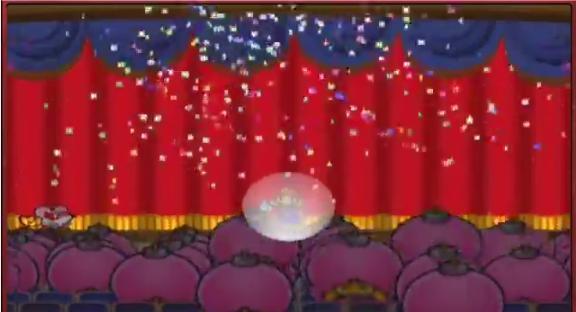
Figure 13: Mario levels up on the battle stage, in a spotlight showered in confetti as the audience of pink Bob-Ombs jumps in approval.
Flip—Super Paper Mario
Two years later saw the release of Super Paper Mario for the Nintendo Wii in 2007. Here we see another shift: instead of the inherently intermedial conception of materiality of Paper Mario RPG—with its constant inclusion of references to the behaviour and possibilities particular to the medium of paper in relation to other media—Super Paper Mario in both aesthetics and gameplay is even more intensely satirical, self-reflexive, and intramedial: it repeatedly highlights the materiality of the digital itself. Mario’s nature as “sprite” (as well as Luigi, Peach, and Bowser’s) for example, is the source of many sight gags and aesthetic flourishes. Calling back to his origins in Donkey Kong as a simple construction of a 16 by 16 square of pixels, Mario is persistently decomposed into his component parts: going into a warp pipe, for example, he flies apart in a cloud of tiny squares, and reforms on the other side (Fig. 14).
One stage is called “The Bitlands” (“Pixeland” in Japanese), which contains parodic versions of famous levels from previous Mario games, with every element built up from exaggerated, block-like pixels (Fig. 15).
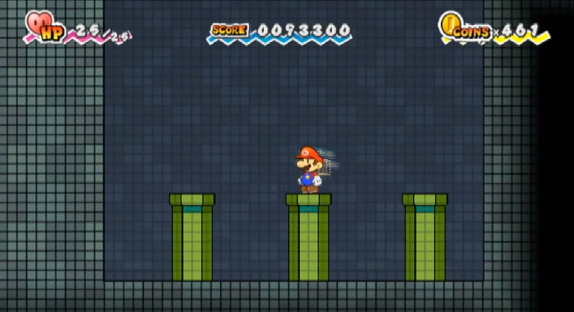
Figure 15: The Super Paper Mario take on the three secret warp pipes from Super Mario Bros. for the Famicom/NES, with every « bit » or « pixel » emphasized by a thick black outline.
When Mario uses his “dimensional technique, » or when a character teleports, a pixellated white arrow cursor appears and clicks and drags a square around the figure. Most spectacular are the effects of two power-up items: the “Pal Pill” (“Otasuke Dotto” in Japanese—“Assistance Dot” or “Assistance Pixel”) which makes eight 8-bit Mario sprites (identical in appearance to those in Super Mario Bros.) surround and aid your character, complete with the original jumping sound effects (Fig. 16), and the Mega Star, which transforms the character into an enormous pixelated version of themselves (again, using the same designs as Super Mario Bros.) (Fig. 17). “The result is a blocky abstraction of Mario-ness,” as the Mega Star’s effect is described in Codename Revolution: The Nintendo Wii Platform; “the grain of the pixels boldly showing, a self-conscious representation of the character as an icon » (Jones and Thiruvathukal, 2012, p. 17).
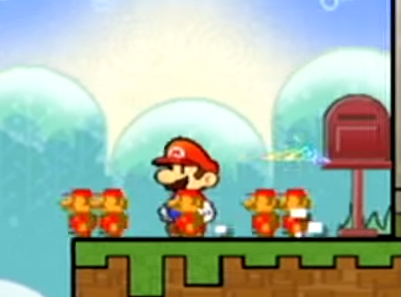
Figure 16: The effects of the « Pal Pill »—Mario becomes surrounded by several clones of his pixellated NES/Famicom self.
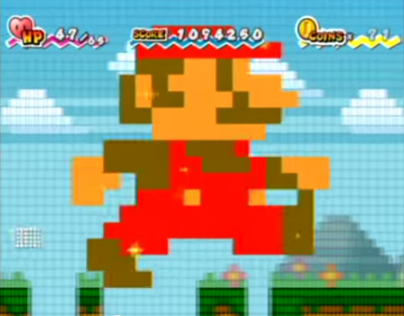
Figure 17: The effects of the « Mega Star »—Mario becomes a colossal, pixellated version of his NES/Famicom self and rampages through the landscape.
The aforementioned « dimensional technique » forms the core of the gameplay and is perhaps the most spectacular and well-known example of playing with dimensionality in video games. At first, Super Paper Mario appears to be a 2D, sidescrolling game much like its NES and SNES predecessors such as Super Mario Bros. and Super Mario World: Mario moves left and right, and can jump onto platforms, across gaps, and onto the heads of his enemies (Fig. 18).
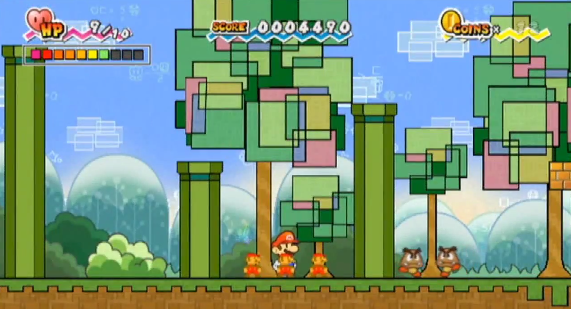
Figure 18: Super Paper Mario in 2D sidescrolling mode—Mario is stuck between two pipes, with no way to get past them to the goombas on the other side.
Yet shortly into the game, he learns the « dimensional technique, » in which the player can press the A button to « flip » from the second to the third dimension. In perhaps the most spectacular example of 2.5 dimensionality in gaming, everything rotates 90 degrees, and the two-dimensional setting is revealed to be made up of flat planes separated by gaps. Flat landscape elements such as blocks, trees, hills and buildings, when viewed from the side, become little more than one-dimensional vertical lines. Mario gains the freedom to move in three dimensions, and by traveling behind and between the gaps, can navigate around obstacles that were seemingly impossible to traverse in their conventional two-dimensional representation (Fig. 19).
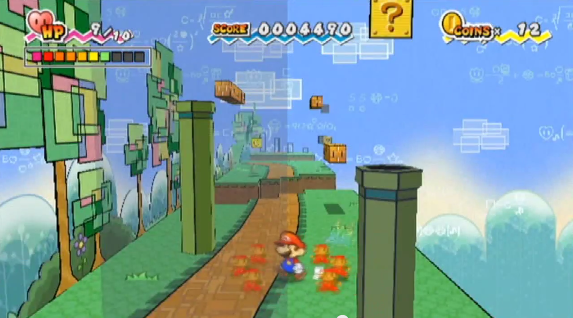
Figure 19: The same scene from Super Paper Mario in 3D mode—turning the world to its side reveals a path between the warp pipes.
In The Anime Machine, Thomas LaMarre explores the functioning of the « multiplanar image » in cel animation: certain techniques of animation, in what he refers to as « closed compositing, » surpress the appearance of movement between layers; « open compositing, » on the other hand, makes the gap between planes and the sliding of the different layers particularly apparent (LaMarre, 2009, p .xxiv). He proposes the two contrasting tendencies of « cinematism » and « animetism. » Cinematism emphasizes Cartesian one-point perspective and the creation of ballistic movement into depth, a voyage into the landscape—similar to the tendency in « realistic » kamishibai described by Orbaugh, the world becomes a target, something to be dominated (LaMarre, .p7). Animetism, on the other hand, associated with open compositing, « is not about movement into depth but movement between surfaces, » and allows the thinking of a freer, more open relation between the viewer and the world (LaMarre, .p7, .p76). « Two-dimensional » sidescrolling platformer games are largely in accordance with the latter tendency. This is most apparent in games such as Super Mario World for the SNES which use a technique called « parallax scrolling, » in which the different background and foreground layers move on top of each other at different speeds (the hills in the far background very slowly, the Mario sprite and the ground on which he walks move very quickly)—this creates a sense of depth, but makes the sliding movement between layers very apparent. With their constant movement into the world on the screen, « three-dimensional » action adventure games like Super Mario 64 (and, of course, first person shooters) tend towards cinematism. Super Paper Mario, as should be expected at this point, ostentatiously blurs the boundaries between these two tendencies, making the gaps between the flat planes comedically visible while allowing for movement not just between, but into them; each stage must be traversed with a combination of two- and three-dimensional movement. Again, it is a 2.5-dimensionality which is foregrounded—one which highlights the constructedness of the game categories in the Mario series before it and in general, while formally creating a constantly shifting, free relation between player, character, game, and world.
Stick—Paper Mario: Sticker Star
If Super Paper Mario exemplifies the series’ playing with dimensionality, perhaps the most intriguing of the Paper Mario games in terms of the relationship between agency, performance and the materiality of digital objects is 2012’s Nintendo 3DS game, Paper Mario: Super Seal (Paper Mario: Sticker Star in English). This game once again begins with a storybook and the voice of a narrator, speaking of the Mushroom Kingdom Sticker Festival; zooming into the illustration on one of the pages, the scene changes into a shot of a stage, upon which Princess Peach announces the beginning of the festivities (Fig. 20).
After the usual Bowser-induced cataclysm, Mario wakes up, but finds that he is crumpled up, some parts of him stuck to others, and it takes a moment for him to right himself into his usual paper form—he has become a sticker himself (Fig. 21).
The titular stickers form the core of the gameplay: Mario travels around, collecting stickers of various sizes to place in his album, which replace not only the conventional support items of an RPG but also represent every attack action (the two most common types of stickers being Hammers and Jumps)—each sticker, however, can only be used once, after which it disappears.
Particularly relevant to the issues under discussion is the “Paperize” ability: Mario’s sticker fairy companion enables him to stop time and transform the environment into a picture, flattening out the visible onscreen area, onto which Mario can then place special stickers in order to recreate his surroundings and get past obstacles (Fig. 22).
Using this ability, landscape features such as doors, bridges, ramps, boulders, fountains and so on can be peeled away and put into the album as “scraps,” which can then be stuck to a new environment. Finally, and perhaps most striking of all, are “Things.” “Things” are everyday objects—shears, bellows, fans, vacuums, cellphones, and so on—represented by hyper-realistic « 3D » graphics in the game and by what looks like actual photographs as stickers, and are the only objects in the Paper Mario: Sticker Star world apparently not made of paper. Mario, however, can transform them into “Thing Stickers,” and use them like the regular stickers in order to attack enemies, solve puzzles, and place them in the gameworld (Fig. 23).
Paper Mario and the Media Mix
Each of these games thus takes a different approach towards intermediality, self-reflexivity, and the kinds of materiality that are highlighted within them, though there are certainly many commonalities between the four. Not the least of these is a constant playing with flatness and roundness, with multiplanarity and one-point perspective, which as a general tendency I am referring to as 2.5-dimensionality. I will now discuss the implications of the aesthetic, mechanic and structural features of the games mentioned so far in a broader sense. By doing so, I hope to point out not only the particularities of the Paper Mario series and the wider Mario media mix, but how they might offer us different ways of thinking about the nature of “media mix” itself.
Paper Mario sets the parodic stance taken up by the rest of the series. Indeed, as mentioned before, the game’s basic concept of flat characters in a two-dimensional world can be viewed as a parody of the Super Nintendo’s “Mode 7,” in which the « 2D » background layer of a game is rotated and scaled in accordance with one-point perspective to appear « 3D », but often with the character sprites remaining two-dimensional (Ryan, 2011, p. 199). Combined with humorous dialogue and visual gags that poke fun at the conventions of Mario games in particular and video games in general, the tone of this and all of the subsequent games might be characterized as irreverent, even anarchic. Yet this tone is combined with a vivid and powerful nostalgia, seemingly every frame and scene packed tightly with references to past Mario games—through design, oblique and explicit references, and repurposing of well-established elements—from the very earliest to the most recent (even including other Paper Mario games) (Fig. 24).
The Paper Mario games thus simultaneously pay homage to past Mario games—consciously presenting aspects of them as iconic and solidifying a canon of elements, character traits, objects, locations, and so on—while deconstructing that same canon by pointing out its own clichés, highlighting absurdities of plot and design, and constantly breaking the fourth wall. This is not just reflected but enabled by the series’ formal elements: its ongoing, even performative hypermediation, focus on materiality, and foregrounding of a spectacularly constructed 2.5 dimensionality.
When I refer to the series’ hypermediation, I am pointing towards the ways in which these videogames ostentatiously incorporate many different medial frames within themselves—creating a kind of mise-en-abyme—putting the player in a complex position in relation to the game, and allowing the game to have a different relation to the concentric frames external to it: the frames of other Mario games, other videogames, other media, of the “real” world in which both we and the game exist. Mario Story is a videogame framed as an oral tale represented by a paper theatre piece; Paper Mario RPG is also framed by an oral narrative, represented by a storybook, which becomes a papercraft world that incorporates miniature theatre pieces; Super Paper Mario is yet another oral narrative, again centered around a book of prophecy, and is closest to a self-reflexive game about games; Super Seal, in what should by now be a familiar pattern, begins with an oral narrative and a storybook, starts with a scene on a stage, and centers around a sticker album.
These games are thus marked as being games by virtue of their incorporation of intermedial frames: a Mario made of paper from a storybook fighting battles on a theatrical stage is also a Mario performing the fact that he is a representation. A representation of what, exactly? Of Mario, the videogame icon, in a story about Mario. The Paper Mario series is a performance, an arts-and-crafts recreation, a mixed-media pastiche of the wider Mario series. This allows it the distance to be intensely self-referential both in terms of thick allusions with the aim of creating a nostalgic feeling, and in terms of highlighting its own construction at every turn and thus creating a space for satire. The player is made to take a position that is at once distant and intimate. They are drawn in by call-backs to games they have played, in-jokes, and the evocation of media such as storybooks, bedtime stories, stickers and kamishibai traditionally associated with childhood; at the same time, the gameplay experience is defamiliarized by the often jarring choice in graphic styles, the unexpected breaking of the fourth wall, and the repurposing of familiar elements in nigh-uncanny ways (most memorably in the aforementioned dimensional shifting of Super Paper Mario, in which conventional gameworlds are made into one-dimensional absurdities with the press of a button).
Again, it is through their commitment to a spectacularized 2.5-dimensionality, along with hypermediation and a particular approach towards digital/paper materiality that never allows the « flat » to remain on its own separate plane, that the Paper Mario games are able to clearly show us the ways in which the concentric circles of framing of the media mix are extended in order to incorporate the “real” world, not only bridging the gap between different « worlds » and dimensions but rendering this boundary indistinct. It is important to emphasize at this juncture that in emphasizing the role of “materiality” I do not mean to create a dichotomy or even continuum with the “material” at one end and the “immaterial” at the other, with the “real” world, physical objects, the body and concrete media in the first category, and the gameworld, digital objects and images, avatars and abstract media in the second. Quite the opposite, in fact—in its intentionally confused, self-reflexive and performative combination of elements from both ends of this hypothetical spectrum, the Paper Mario series reveals such categorizations to be arbitrary, and « playing » within this (and any) media mix can be considered to be the act of traversing the boundaries between them.
By highlighting precisely where such distinctions break down, these games allow us a way into an alternative conception of the media mix. Instead of “media mix” used as a way to describe how contents, settings, worlds and characters are expressed across and through a variety of medial platforms and are variously changed or unchanged by each medial articulation, this conception of the media mix takes as its baseline the extreme porousness of the boundaries between media, or even between « media » and « non-media. » The Mario world does not end at the boundaries of its constituent games and merchandise; the real world does not end at the edge of the Mario world. This view of the media mix is a way of recognizing particular intensities, particular instances of Mario-ness, without bracketing off players’ bodies, homes, and environments as inherently distinct from « media. »
Take, for instance, Paper Mario: Sticker Star/Super Seal and its complex relationality of worlds—in particular, its own and “ours.” It is initially framed as an oral narrative: “Ahem! Today’s story begins one evening during a holiday called Sticker Fest,” begins the narrator in the English version of the game (Paper Mario: Sticker Star, 2012). Behind this text is a storybook, which flips open to pages illustrating what the narrator says; at one point, the camera zooms into a particular illustration, the book falls away, and we enter the particular world of the game itself, with just about everything made of paper. After the usual catastrophe, as mentioned before, Mario receives a sticker album from a helpful sticker fairy; he then goes on to peel off stickers of hammers, mushrooms and jumping shoes where they have been stuck all over the landscape. This is a rather strenuous task for him: one must hold down the A button as Mario hooks his hands under the side of a sticker his own size, braces himself with his feet, and pulls with all of his might before it finally comes off, the physicality of unsticking consistently brought to the fore (rather than, say, just adding stickers to your book by touching them with the stylus) (Fig. 25).
Yet these are only the “conventional” stickers. As mentioned before, Mario (and his foes) can also “paperize” the entire landscape, as if a screenshot were taken and turned into a flat sheet of paper, which then tilts as if it were laid on a table in front of the player (another callback to the 2.5 dimensional projection of Mode 7). In this mode, elements of the landscape itself can be torn out to become stickers, or stickers can be placed to become new landscape elements that become three-dimensional once the “paperization” is reverted.
An early scene provides a good example of this function: before Mario can cross a river, Baby Bowser confronts him, paperizes the scene, rips out the bridge leaving a gaping void, and crumples it up in his hand; after the scene unflattens, and now with no bridge across the raging river, Baby Bowser throws the crumpled-up ball of paper onto a distant mountain, taunting Mario all the while. Once Baby Bowser departs and Mario retrieves the crumpled-up bridge, the player must paperize the river scene again. It should be re-emphasized here that the game is for the Nintendo 3DS system and incorporates 3D functionality—not just « 3D » animation, but using parallax layers of plastic in the upper screen to give the illusion both of depth and that certain elements are coming out of the screen, as in a 3D movie. So the paperized landscape has the appearance of a flat piece of paper half-emerging from the screen, on top of which a flat Mario floats in a space seemingly halfway between the gaming device and one’s eyes, an ostentatious blurring of the “game” and “real” worlds by means of 2.5 dimensional space. The player uses the stylus on the bottom screen to select the crumpled-up bridge and then place it on the void where it used to be, but it still curls up at the edges; using the stylus again, with Mario hovering above its point, one then must laboriously smooth it out until it fits into place.
Another example of this blurring between « game » and « real » worlds through 2.5-dimensional aesthetics and an emphasis on the materiality of digital objects are “Things. » « Things » are hyper-realistic-looking objects that are emphatically not made out of paper, and are implied to be strange and illegal within the gameworld and are sold in black markets. Far from being the expected mystical artifacts, they are actually everyday domestic objects from our “real” world like scissors, flashlights, and electric fans, yet surreally stand out in the context of the Mario universe where everyday objects are magic stars and fire flowers. These objects can be transformed into stickers by throwing them at a special board, and in another sight gag the sticker icons are almost indistinguishable from photographs of real objects, increasing the uncanny quality of their presence in a Mario game. Through the above-mentioned paperization process of the landscape, they can be stuck into a scene and transformed from a sticker into polygonally rendered landscape elements, at last in a similar aesthetic to their surroundings—to return to a previous example, one puzzle features the triumphant reincorporation of the electric fan into the gameworld, now made enormous and used to power a windmill (Fig. 26).
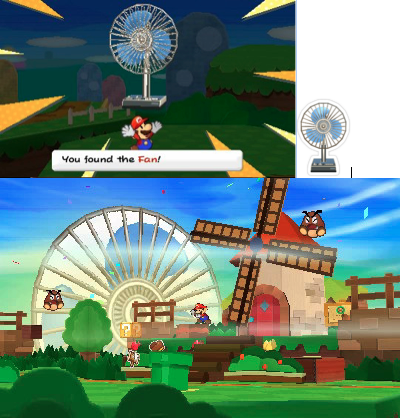
Figure 26: Mario finds the Electric Fan, makes it into a sticker, and later places it (now massive) into the landscape.
The game world is made of paper, and made into paper; Mario peels off stickers with great strain, and the player, too, must actively stick things back on by using the 3DS’s stylus (or even their fingers). The three-dimensional becomes near-photographic, the near-photographic becomes a two-dimensional illustration, the illustration becomes 2.5-dimensional (in the conventional sense) but mediated by 3D technologies, appearing to come out of the screen. It should also come as no surprise that along with Sticker Star’s release came a physical sticker book, nearly identical to the one in game (Fig. 27); using it, one becomes Mario, collects Mario, sticks and unsticks Mario. Paper Mario is made physical as a sticker out of game, digital as a virtual sticker in game. As a Mario stand-in, you collect and stick, and as a player stand-in, Mario collects and sticks.
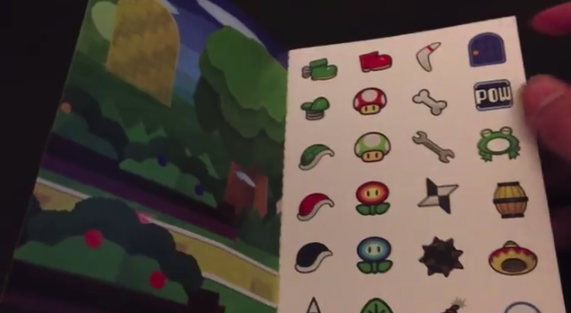
Figure 27: The Sticker Star sticker book, given out by Club Nintendo. Still from a YouTube video by James Berryman.
In his book Anime’s Media Mix: Franchising Toys and Characters in Japan, Marc Steinberg highlights the transformative potential of the sticker, and its central role in the explosive propagation of Tetsuwan Atomu (Astro Boy)’s media mix in postwar Japan. He examines how stickers, like all commodities, « in their interaction with media forms, produce desire and transform modes of consumption, » in this case paving the way for the « dominance of character merchandising » (Steinberg, 2012, p. 70). Key to this phenomenon is synergy, in the case of Atomu particularly taking the form of « visual consistency across incarnations » (Steinberg, 2012, p. 71). The form of limited animation which the Atomu television series pioneered highlighted character images that were still, but managed to retain a sense of movement (what Steinberg calls « graphically immobile dynamism »), allowing for the stickers to look identical to the depiction of Atomu in the anime but still be imbued with a sense of movement, without a « gap » between representations of a character in, say, a manga and a live-action movie that might hinder such a spread (Steinberg, 2012, p.78–79, p.72). In addition to this synergy derived from sameness was a surplus of function through material difference—the anime gave « movement and intensity » to the sticker, but the sticker in turn contributed their own material specificity, in particular their « portability, » « stickerability » (adhesiveness, ability « to be placed anywhere and on any surface ») and ability to be « seen anytime » (Steinberg, 2012, p. 79). Atomu could thus « accompany young fans in all areas of their lives, » not limited to the manga or the television screen but through the sticker gain the ability to adorn refrigerators, clothes, books, walls, and so on—the boundaries between the world of Atomu and our world thus become less distinct (Steinberg, 2012, p. 79).
Paper Mario: Sticker Star functions as a video game performance of many aspects of Steinberg’s conception of the Astro Boy media mix. The fact that the majority of stickers in the game disappear as soon as you use them, while noted as strange by many reviewers, rightly emphasize a key function of the sticker as the act of sticking, unsticking and resticking itself, as much as what the sticker may look like or represent. As Steinberg points out, the graphical consistency between the Astro Boy stickers and the anime on which they were based was an important reason for their popularity, and similarly characters from Paper Mario (due to their graphic flatness) lend themselves particularly well to merchandizing on paper goods like stationery or stickers, allowing for their ubiquity in Mario-themed goods and fan creations to an extent seemingly disproportionate to the popularity of the Paper Mario games themselves (Fig. 28).
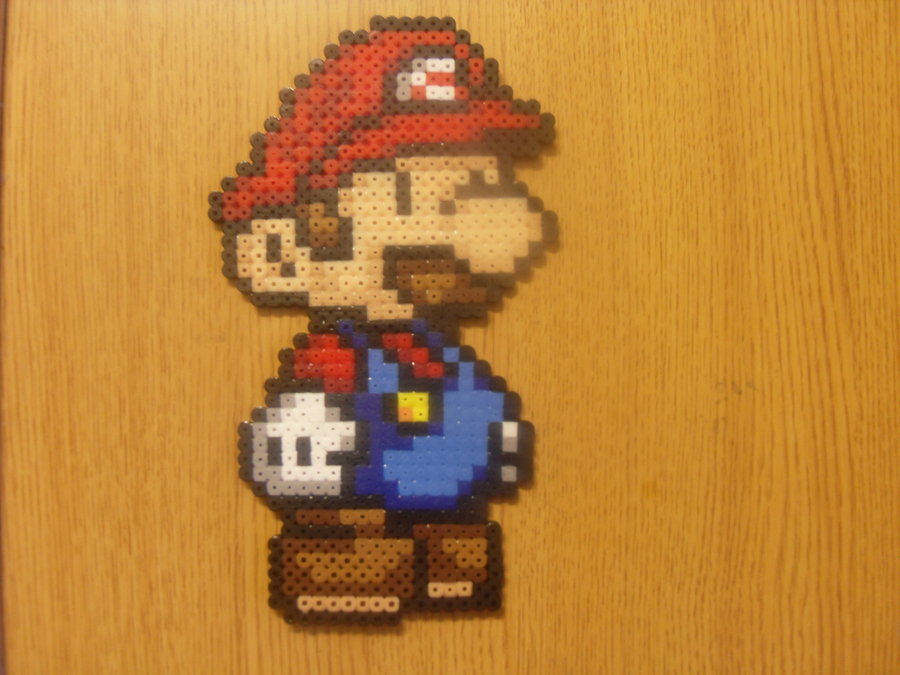
Figure 28: « Perler Mario, » a craft by DeviantArt user Biddehdude.
Furthermore, in the case of Sticker Star we have an additional form of consistency: a consistency of action. An intense relation between player, character and world in Sticker Star centres around a kind a unity generated from the act of sticker adhesion shared by the player and the character, an mode of embodiment that not only crosses the “boundaries” of the real and game worlds, and the « two » and « three »-dimensional, but renders them unimportant, enveloping player, character and game in 2.5-dimensional space. Stickers in Sticker Star are indeed stored in an album, but are not left there to collect dust like trophies sitting on a mantelpiece. They linger there for a while only before being unstuck and restuck in an act of physical association between media commodity and world; through stickers, the so-called two-dimensional reveals itself to be inextricable, even intimate with the « three »-dimensional, and especially with the body. Mario can become part of the « real world » environment by the proliferation of medial objects such as stickers and other merchandise into domestic and public space, and in Sticker Star, this process occurs simultaneously with Mario’s world being populated by “real world” objects like the electric fan.
Looking at a series of video games like this that spectacularizes 2.5 dimensional aesthetics by means of emphasizing the materiality of paper allows us to resist monolithic conceptions of « 2D » and « 3D, » in favour of more subtle articulations such as flatness-with-heft and solid-seeming structures made out of the conjunction of thin planes. Furthermore, by foregrounding the in-between mode of the 2.5D and using it as the « base state » of the media mix allows for a more holistic viewpoint than one more allied with either the realm of the 2D (emphasizing media products in and of themselves and their relations to one another in form/content) or the 3D (emphasizing patterns of production, distribution and consumption in the « real » world). “Paper” and “the sticker » are fitting symbols of this conception of a possible media mix as a stance or viewpoint that does not recognize intrinsic distinctions between medial and non-medial objects, two- and three-dimensionality, real and media worlds, or even people and characters. “Paper” is flat and two-dimensional but can be folded, crumpled, ripped, curled, and so on, all actions that are necessitated on the presence of three-dimensional space. The realm of the flat, the graphic, and of the image, when linked to a physical object like paper, ceases to be something “other-worldly” (whether imaginary, digital, or virtual), but something immanent, embedded, firmly of this world.
While these are only preliminary considerations and by no means present a systematic model by which to evaluate video games in the context of the « media mix, » it is my hope that following the example of the Paper Mario series might lead us toward a broader conception of the media mix and the research that might be generated from it, one that emphasizes not only the relations between discrete and overdetermined categories of media and non-media—like « novel, » « CD, » « GameCube game, » « keychain, » « gamer, » « arcade, » and so on—but also specific articulations of such things as « Mario-ness » that are embodied, concretized, and not necessarily bound by the screen or the page. Consider a conception of a media mix in which all of the following are integral parts, and all possible objects of analysis: Mario in a commercial, as a giant sheet of paper, standing on the tarmac of Narita airport; the commuters who no doubt saw that commercial, time and time again, played on screens during their train rides, with DSes in their pockets, game temporarily put to sleep; the Mario-embellished sheets of paper sent to thousands across the world, ready to be folded into airplanes; Mario in game, battling on a stage, a photographic sticker of a « real-world » faucet in his album, ready to use at a moment’s notice; a Mario sticker embellishing a faucet in a bathroom sink; a matching sticker emblazoned on a laptop, with which the user « posts » on message boards, and “stickies” a thread to be preserved at the top of a Mario forum; and, finally, Mario again, jumping up off the runway, folding himself up and flying off into the distance (Fig. 29) .
Acknowledgements
This research was supported by the Social Sciences and Humanities Research Council of Canada.
References
JONES S. E. & THIRUVATHUKAL G. K. (2012), Codename Revolution: The Nintendo Wii Platform, Cambridge, MA, MIT Press.
LAMARRE T. (2009), The Anime Machine, Minneapolis, University of Minnesota Press.
ORBAUGH S. (2012), “Kamishibai and the Art of the Interval”, Mechademia 7, p. 78–100.
“Pēpā Mario RPG” (2004), Nintendo Online Magazine, July, no. 7, Web, July 2013, <http://www.nintendo.co.jp/nom/0407/1_2/index.html>.
RYAN J. (2011), Super Mario: How Nintendo Conquered America, New York, Penguin Group.
STEINBERG M. (2012), Anime’s Media Mix: Franchising Toys and Characters in Japan, Minneapolis, University of Minnesota Press.
Video games:
Mario Story. Nintendo. 2000. Nintendo 64 video game.
Paper Mario. Nintendo of America. 2001. Nintendo 64 video game.
Paper Mario: Sticker Star. Nintendo of America. 2012. Nintendo 3DS video game.
Paper Mario: Super Seal. Nintendo. 2012. Nintendo 3Ds video game.
Paper Mario RPG. Nintendo. 2004. Nintendo GameCube video game.
Paper Mario: The Thousand Year Door. 2004. Nintendo of America. Nintendo GameCube video game.
Super Mario 64. Nintendo. 1996. Nintendo 64 video game.
Super Mario Bros. 3. Nintendo. 1988. Famicom video game.
Super Mario Kart. Nintendo. 1992. Super Famicom video game.
Super Mario RPG. Nintendo. 1996. Super Famicom video game.
Super Mario World. Nintendo. 1990. Super Nintendo Entertainment System/Super Famicom video game.
Super Mario: Yoshi Island. Nintendo. 1995. Super Famicom video game.
Super Paper Mario. Nintendo. 2007. Nintendo Wii video game.
Yoshi Story. Nintendo. 1997. Nintendo 64 video game.
Andrew Campana is a doctoral candidate in the Department of East Asian Languages & Civilizations at Harvard University, with research interests in modern Japanese poetry, media, and game studies. Over the next academic year, he will be in Tokyo under a Japan Foundation doctoral fellowship for dissertation research, with a project tentatively titled « Poetry Across Media in 20th-Century Japan. »
Résumé
La série Paper Mario de Nintendo est, au niveau esthétique et mécanique, centrée autour des interactions entre le plat et le solide; à son centre s’y trouve un esprit ludique axé sur la dimensionnalité et mettant l’accent sur non seulement sur le bidimensionnel ou la tridimensionnel, mais sur une dimensionnalité 2.5. A travers ce filtre, j’analyse chacun des quatre jeux vidéo de la série Paper Mario, ainsi que leurs prédécesseurs et leurs produits associés. Cette dimensionnalité 2.5, constamment thématisée dans ces jeux, nous permet de penser une conception plus holistique du « média mix », une conception qui brise non seulement les distinctions entre différents médium, mais aussi entre les mondes « intérieurs » et « extérieurs » aux jeux eux-mêmes.
Mot-clés: Jeux vidéo, média mix, Nintendo, Mario, dimensionnalité

